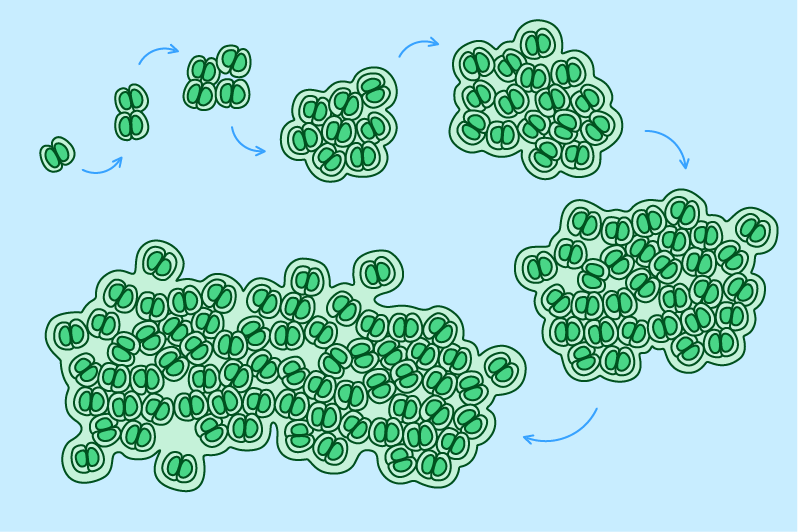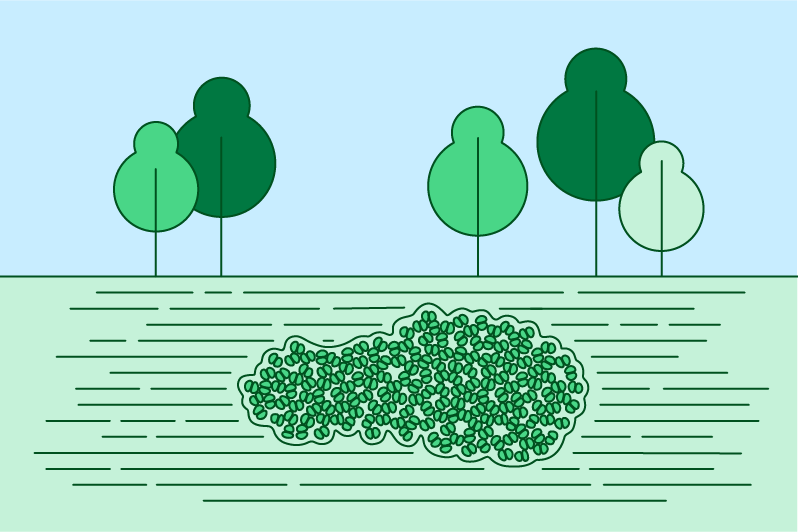CO2 Removal & Storage with Microalgae
We permanently remove CO2 from the atmosphere by growing and burying microalgae.
Biomass Carbon Removal and Storage (BiCRS) combines photosynthesis with technology. Our outdoor photobioreactors create ideal conditions for the rapid growth of microalgae biomass in fresh water using sunlight. Through photosynthesis, the algae bind CO2 from the atmosphere as a natural process. That’s why our BiCRS approach is energy- and cost-efficient.
Our Process
Photosynthesis in algae has been optimized over millions of years of evolution. We adapt this already highly efficient process and enhance it with technology for our approach to biomass carbon removal and storage. It involves three steps:

1. Growth
In our photobioreactors, algae grow by cell division. They thrive in natural light and are supplied with nutrients and CO2 from the atmosphere. During photosynthesis, the algae bind CO2 and the produced oxygen is released into the atmosphere.

2. Harvesting & Drying
As soon as the algae have reached a certain density, harvesting begins. Part of the biomass is continuously filtered from the water and dried. The dried biomass consists of more than 50% carbon.

3. Storage
The carbon-rich biomass is stored underground for the long term, e.g. in disused gravel pits or underground mines. The process therefore has a negative CO2 balance and is considered a negative emission technology.
Benefits of our Solution
MEASURABLE
We weigh the biomass and measure its carbon content before we bury it. This allows us to determine exactly how much CO2 has been removed from the atmosphere. With 1 kg of algae biomass about 1.8 kg of CO2 can be removed.
PERMANENT
The composition of the dried biomass and suitable storage conditions, such as pH value and water content, ensure that it remains stable for over 1000 years. This means that the removed carbon is permanently locked away.
ENERGY-EFFICIENT
Sunlight is the main energy source in our approach. Therefore, we only need about 1.5 kWh of technical energy to bind 1 kg of CO2. We avoid transport or keep distances short by operating our bioreactors in the immediate area of the storage site.
ADDITIONAL
Our process verifiably removes additional CO2 from the atmosphere on your behalf. This avoids double counting of our CO2 removal certificates.
VERIFIABLE
We attach great importance to a high standard of monitoring, reporting and verification (MRV) to ensure transparency and verifiability of our process.
SCALABLE
Our photobioreactors enable the highly efficient production of biomass for CO2 sequestration. They are modular, scalable and plug & play ready for installation.
What are Negative Emission Technologies?
Negative emission technologies (NET) include technological approaches and strategies to remove carbon dioxide (CO2) and other greenhouse gases such as methane (CH4) from the atmosphere. By definition, more CO2 is removed than is emitted by the application of the technology. NETs therefore reduce the overall concentration of CO2 in the atmosphere and its impact on global warming.
The negative emission technology developed by Arrhenius is based on microalgae.

Why we need negative emissions
Negative emissions are not a substitute for drastically reducing greenhouse gas emissions! Avoiding CO2 at its source remains the most effective and urgent strategy to address climate change.
The transition to renewable energy and other non-fossil resources is progressing, but it will take time. Some emissions may not be reduced fast enough. In addition, there will always be CO2 emissions that are hard-to-abate or unavoidable, such as those from agriculture or waste incineration. These emissions can be tackled with negative emission technologies.
What other NET exist compared to Microalgae Cultivation?
There are various natural approaches and technologies to reduce the concentration of CO2 in the atmosphere. Each has its advantages – and we need them all to achieve our climate targets.
Frequently Asked Questions
CO2 removal & negative emissions
Why do we need to remove CO2 from the atmosphere?
To mitigate climate change and limit global warming to 1.5°C above pre-industrial levels, we must achieve net zero CO2 emissions by 2050 at the latest. Reducing emissions is the most important and effective measure. But there are some emissions that can’t be avoided or reduced fast enough. To counterbalance these emissions and achieve net zero, we need to remove CO2 from the atmosphere.
Why not just plant more trees?
Planting trees makes perfect sense and is important for mitigating climate change. However, afforestation and reforestation have their limits in terms of their scalable capacity to absorb CO2. They alone are not sufficient to achieve the negative emissions required for net zero.
Why not remove other greenhouse gases such as methane (CH4) or nitrous oxide (N2O)?
The focus is on CO2 removal, as this is the predominant greenhouse gas associated with long-term climate change. Although methane and nitrous oxide are more potent greenhouse gases, they have shorter atmospheric lifetimes than CO2. Reducing these gases is also essential and requires specific strategies, such as improving waste management and reducing agricultural emissions.
How much CO2 can be removed with algae biomass?
For every carbon atom stored in biomass, one molecule of carbon dioxide is removed from the atmosphere. As carbon atoms (C) are much lighter than carbon dioxide (CO2) molecules, 1 kg of carbon stored in biomass is equivalent to removing 3.7 kg of CO2 from the atmosphere. So if the biomass is 50% carbon, 1kg of biomass removes about 1.8kg of CO2 from the atmosphere.
Why the name "Arrhenius"?
In 1896, Svante Arrhenius was the first to predict global warming due to human-caused CO2 emissions. He suspected that CO2 absorbs the infrared heat rays of the light emitted by the Earth and that the Earth’s climate could heat up due to excessive levels of CO2 in the atmosphere. We are impressed by his foresight and would like to pay tribute to him.
Algae & biomass storage
What kind of algae do you use?
We use freshwater green microalgae with a high growth rate and a high carbon content to ensure a high CO2 capture rate.
Are the algae toxic or harmful to the environment?
No, the algae are not toxic or harmful to the environment. You can even eat them.
Why don't you just burn the algae?
When the algae are burned, the previously bound CO2 is released again. In this case, the process would only be CO2 neutral, not CO2 negative.
How and where is the algae biomass stored?
The algae biomass can be stored in a wide variety of locations. The most obvious sites are opencast lignite mining areas or underground mines of various types (copper, salt, coal, etc.).





